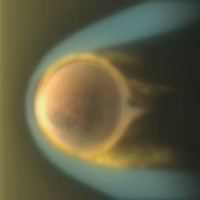Mars Express science highlights:
#6. Estimation of the current rate of atmospheric escape
Where did the water and the atmosphere go? There are two main possibilities. Observations show that a substantial amount of water exists as subsurface ground ice, in polar ice caps and hydrated mineral deposits. However, it also seems likely that much of the atmosphere – including its water vapour - was lost to outer space.
Researchers have proposed a number of theories to explain how Mars changed from a warm, wet place to the cold, dry place it is today. This change may have involved the escape of water, carbon dioxide and other ‘volatile’ substances that would have evaporated relatively easily.
 |
|
Interaction between the solar wind and the upper atmosphere of Mars. Credit: ESA (View the animated version here.) |
A key investigation of this process has been undertaken by the ASPERA-3 (Analyser of Space Plasmas and Energetic Atoms) instrument on board Mars Express. ASPERA-3 was designed to answer the question of whether the solar wind interaction with the upper atmosphere of Mars contributes to the depletion of water. It does this by measuring a process called ‘solar wind scavenging', the slow escape of volatile gases from the planet’s upper atmosphere.
Using plasma spectrometers and a special imager to detect energetic neutral atoms, ASPERA-3 made global, simultaneous measurements of the solar wind (the flow of charged particles from the Sun), the inflow of energetic particles, and the outflow of particles from the martian atmosphere and ionosphere – the region where the solar wind interacts with the upper atmosphere.
The data showed that the ionosphere can vary in shape and composition over time scales as short as a few minutes, and that the solar wind can penetrate deep into the martian atmosphere. The solar wind then energises and ionises (electrically charges) the gases in the ionosphere and the uppermost atmosphere. By exchanging charge, ions of hydrogen and oxygen, as well as ionised molecular species, such as carbon dioxide (which were trapped by the planet's magnetic field), become neutral and are able to escape into space.
Other particles are photoionised by solar ultraviolet radiation, after which they can be picked up directly by the solar wind and carried away. In this way, the solar wind continuously erodes the atmosphere of Mars.
The ion instrument on ASPERA-3 has enabled a unique global analysis of the mass composition and escape rate of planetary ions. This process is dominated by hydrogen and oxygen ions (i.e. water), whereas the escape rate of carbon dioxide (CO2) is extremely slow, even though it is by far the most common gas in the martian atmosphere.
The ion escape rate is highly variable, depending strongly on the solar wind and ultraviolet flux. The calculated escape rate over the last 3.5 billion years appears to be insufficient to account for most of the planet’s assumed atmospheric loss. Clearly, ion escape is not an efficient way to remove the martian atmosphere. It seems that some other mechanism is required, such as the loss of neutral atoms from the upper atmosphere, in addition to storage of water and other volatiles beneath the planet’s surface.
